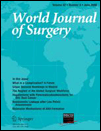Risk Factors for Wound Infection After Surgery for Colorectal Cancer
Abstract
Background
Among complications after surgery for colorectal cancer, wound infections may prolong hospitalization and increase healthcare costs. This study was designed to clarify the incidence, risk factors, and pathogens responsible for wound infections after surgery for colorectal cancer.
Methods
The study group comprised 144 patients (94 men and 50 women) with colorectal cancer in whom the same surgeon at Kitasato University Hospital performed resection from January 2004 through December 2005. Their mean age was 67.1 years (range = 38–90). To identify risk factors for surgical wound infections, we examined the following 11 variables: gender, age (>65 vs. ≤65 years), body-mass index (>25 vs. ≤25 kg/m2), the presence or absence of diabetes mellitus, physical status according to the American Society of Anesthesiologists classification (ASA score), stage of cancer according to the TNM staging system, surgical procedure (laparoscopic colectomy vs. open colectomy), procedure type (right colectomy vs. left colectomy vs. anterior resection), operation time (>180 vs. ≤180 min), intraoperative bleeding volume (>120 vs. ≤120 ml), and the presence or absence of intraoperative transfusion. Tissue specimens of infected wounds were cultured to identify pathogens.
Results
Postoperative wound infections occurred in 12% (17/144) of the patients. In univariate analyses, the incidence of wound infection was 26% (11/43) in patients who underwent open colectomy compared with 6% (6/101) in those who underwent laparoscopic colectomy. This difference was significant (P = 0.001). In multivariate analyses, only surgical procedure was identified as an independent risk factor for wound infection. The odds ratio for open colectomy compared with laparoscopic colectomy was 3.322 (P = 0.021). Pus from infected wounds was cultured in 7 of the 17 patients and cultures were positive for pathogens in 5 patients: 1 laparoscopic colectomy and 4 open colectomy. Bacteroides species were the most common pathogen.
Conclusion
To prevent wound infections after surgery for colorectal cancer, laparoscopic surgery should be performed when indicated.




